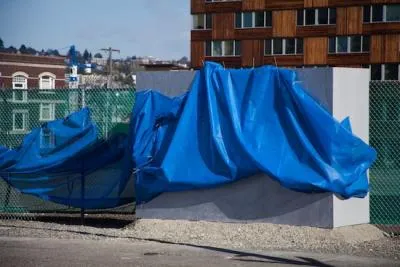
Arts: Who Are the Mysterious Curators Behind the City’s All Rise Project?
How the city temporarily ceded a future building site to local artists with a secret agenda.
By Kelton Sears Tue., Apr 29 2014 at 04:51PM
I’m standing in an empty lot. Two curators are with me, but they don’t want me to use their names. “Pretty FBI, eh?” they joke. The only things here are the three of us, their two cars, and a whole lot of nothing.
It’s odd to stand in a yawning vacant lot in Seattle, where almost every buildable site is being built upon—especially here in the heart of the Cascade neighborhood, with Amazon close by. I’m near Denny Way, standing in the middle of 90,000 square feet of nothing. It’s both unnerving and strangely meditative.
The curators and I circle the fenced expanse, gravel crunching softly beneath our feet. It’s 10 a.m. on a Saturday. The city is just beginning to wake up, and so are we. Clutching a coffee, Curator A notes the enormous construction cranes nearby. When people talk about gentrification, they often point to these cranes—emblems of our paradoxical struggle for progress and preservation.
But there aren’t any such cranes where we stand. Not long ago, this spot was a Greyhound bus maintenance depot, close to the actual Greyhound station on Stewart Street (also slated to be demolished and moved). Next year, Seattle City Light will begin building a large electrical substation here, its first in 30 years, to serve booming South Lake Union, Uptown, and the Denny Triangle.
Until then, funded by the city’s 1-percent-for-art program and sponsored by its Office of Arts & Culture, these two mystery curators have been given a chance to bring poetry and other art installations to the empty block (bounded by Denny, John Street, Pontius Avenue North, and Yale Avenue North). All Rise is a purposefully enigmatic 18-month-long endeavor that began this spring. The less you know about it, the better, the curators insist. What they want is for you—possibly during this Friday evening’s South Lake Union Art Walk—to notice the strange, wonderful things they’ll host here. Pay attention, in other words. Be on the lookout for sporadic, spontaneous happenings as you’re walking or driving past.
The project began with a poem by Arne Pihl, some of its text writ large on the lot’s boundaries. Motorists couldn’t help noticing the words “THIS IS NOT A GENTLE POEM” blaring at them, printed in large white vinyl lettering on plinths around the site. Anybody curious enough to look more closely would find that the words were just one line of a longer poem inscribed on 11 signs hanging from the chain-link fence. Pihl’s poem “Here” served as an apt opening for All Rise, a guerrilla reminder of the history of this valuable parcel of real estate.
It begins in the Ice Age:
For ten thousand years/Children napped here/Learned the difference between wing and leaf/In Lushootseed, Swedish, Norwegian, Russian, English and Greek/While parents labored, laughed, carved livelihood and dignity/From woods, lake and streets/But first the ice/Towering right here two miles thick/Grinding silt from rock as it carved the belly/It would lay into one day/For fluid dreams and restless sleep/Below the traffic of Mercer Street
Today this lot is flanked by offices, apartments, REI, The Seattle Times, convenience stores, and the Mirabella senior living home. They provide the audience for this arcane and very mutable project. The curators have made the rapid installation of new iterations of All Rise a guiding principle. Says Curator A,“With public art, there’s always that ‘Is it done yet?’ question the viewer has as they watch things get built. We want to install things quickly, so people don’t have that sense.”
Despite such would-be stealth, they’ve already been caught a couple of times. After “Here” went up, a Mirabella resident out on a stroll found one curator on a ladder. “I don’t know what you’re doing,” he told them, “but thanks for whatever this is. Please tell the poet I was really moved.” The Mirabella then got permission to print Pihl’s poem in its monthly newsletter.
“We hope All Rise allows us to understand how impactful an empty lot is. People have a bodily reaction to their environment,” Curator A tells me as we inspect the second installation on the site.
Jenene Nagy, who specializes in draping, created a billowing ocean wave of blue construction tarps that dangle gently from the fence. If you pass by quickly, offing might look like normal building material. But when you stop to consider its elegant shape and the fact that the tarps are tied to the outside of the fence in a long loping gesture, you realize that perhaps they have some quiet purpose.
These first two manifestations of All Rise are meant to be small, quiet, and almost subliminal. In time it will grow. How exactly, I’m not allowed to say. But more will spring up here.
“You can’t conquer this land,” says Curator B. “There’s so many things looming over you in the city. We don’t need more looming. Instead, we think of All Rise as more of an invitation. Everyone in this neighborhood has a chance to build a relationship with it, if they choose to watch. This space is a stage for the neighborhood, and we hope to build layers of community interaction and set up a pattern of expectation for the people here.”
Eventually people will be allowed through the fence and things will happen inside. The curators mention dance, performance, structural pieces, sculptural pieces, and music. In this way, All Rise is very much an interstitial endeavor that indicates a place in transition. Between demolition and new construction, this parcel is on hiatus.
“This time will be a period of rest for the neighborhood, and for this land,” says Curator B. “The reason we made the poem is to have people start considering that emptiness.”
http://www.seattleweekly.com/arts/952255-129/arts-who-are-the-mysteriou…
ALL RISE Denny Way & Pontius Avenue North, seattle.gov/arts/publicart, allriseseattle.org.